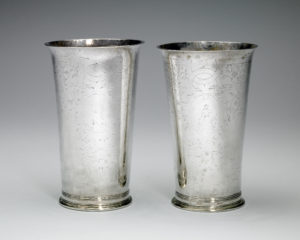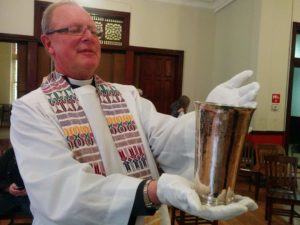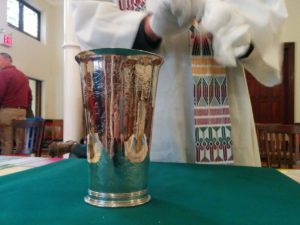Pastor Meeter and the Case of the Seven Silver Beakers

Old First’s antique communion cup, or Avondmaalsbeker in Dutch. Photo by The New-York Historical Society
When Pastor Daniel Meeter joined Old First in 2001, he had read in one of the church’s histories that there existed an antique communion cup (Avondmaalsbeker in Dutch. Avondmaal means Lord’s Supper).
It’s whereabouts: unknown. Pastor Meeter asked around, but nobody had heard of it or even seen it. A true mystery.
“I saw a picture of a former pastor from 40 years ago holding one,” Pastor Meeter says, “so I kept looking around.”
His search — which by now had stretched from months into years — had led him to Michael Otte, a former pastor who now lived in Tarrytown, NY. Michael’s memory opened up a long-awaited clue: the beaker may be kept in a safe deposit box of a bank.
But where?
Pastor Meeter visited all the banks in the area, checking safe deposit box records. Even the bank which handles the church’s finances, Citibank, had no clue. The ultimate results: nothing.
Eventually, Pastor Meeter received a call from Chase Bank, which used to be Manufacturers Hanover (Manny Hanny) back in the day. Although there was no record of a silver beaker, the staff happened to be cleaning out the branch’s basement and came across a simple locked wooden chest sitting on top of a bookcase. Apparently, it had been sitting there for years, untouched and unnoticed. They asked the pastor if he wanted to investigate further.
Pastor Meeter had no keys to the locked chest, but he had street smarts. He came with a screwdriver and quickly picked the lock.
At last: mystery solved.
Inside the chest were seven silver beakers. Two of them, it turns out, were made in 1684. The other five were created in the 19th century. Most of them were inscribed in Dutch, including the name Joralemon, for whom the Brooklyn street is named. There were some other well-known names listed, like Remsen (another Brooklyn street).

“This is something tangible that connects us to our past.”
“Apparently, over the years, the older elders would only have communion four times a year, far less frequently than we do,” Pastor Meeter explains. “The elders would keep the communion-ware in the bank. I found a little record book inside the chest. The elder would pick it up on a Saturday, sign it out, use it at the church, and then bring it back to the bank for safekeeping the next Monday, four times a year.”
The pastor had the beakers examined by an expert at the Metropolitan Museum of Art. She had verified all of them, informing Pastor Meeter of an exhibit at the New York Historical Society of a young Dutch woman in early New York, Marguerite Van Varick. We know that her husband, who was a preacher, used these beakers.
“This is something tangible that connects us to our past,” Pastor Meeter says.
We had the beakers photographed, cleaned by the New York Historical Society, and placed in the exhibition catalog. We also made an agreement with the museum that they would keep them in their collection for safekeeping. One is in the children’s museum downstairs; one is in the collection of early American silver upstairs.
“The museum doesn’t own them; we retain possession,” Pastor Meeter says. “We take one out every year for use in our service. They always give us the one that is in the children’s museum.”
While it’s in use, a card takes its place at the museum that states that the beaker is currently being used by the church which owns it. The beaker is currently in use for special celebration services.

“We keep the beaker for two Sundays,” Pastor Meeter says. When picking up the beaker from the museum, “I call ahead. They expect me, and when I arrive for the beaker, they pack it for me.”
The beakers’ insured value: $80,000 each. The museum helps to preserve them by keeping them under special atmospheric conditions.
“Think about how many lips have touched it,” Pastor Meeter says. “Thousands have drunk the blood of Christ from it: Dutch, French, Germans, Canarsie Indians, slaves, free Africans, British soldiers during the American Revolution. The silver has been reflected in all the churches it has been in. It’s been used by thousands of people for a very sacred experience.”
